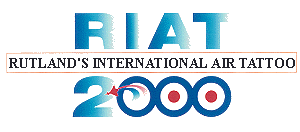 |
Rutland's International  Air Tattoo 2000 Air Tattoo 2000 |
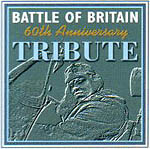 Part Three:
Themes Part Three:
Themes
Tribute to the men and machines of
the Battle of Britain
'Cat's
Eyes': A legend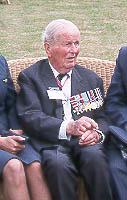
Group Captain John Cunningham
CBE DSO** DFC* AE DL.
John Cunningham, exactly one week away from
his 83rd birthday at RIAT, was one of the best fighter and test pilots of a whole
generation of daring young aviators. In 1935 he joined the de Havilland Technical School,
and later that year was accepted by 604 Squadron for flying training.
When war broke out in 1939, 604 Squadron, designated as a Day & Night Fighter
Squadron, was equipped with the Bristol Blenheim Night Fighter. During the Battle of
Britain blitz on London, John Cunningham was already developing airborne radar - the new
technology which was to give him his wartime nickname of 'Cat's Eyes' Cunningham. He
commanded 604 Squadron from 1941 to 1942.
The War Ministry colluded with the media in spreading stories such as this one from the
Daily Sketch, in an attempt to keep airborne radar secret from the Luftwaffe. "He is
called 'Carrots', because of his sandy hair and because he eats carrots to keep his
eyesight keen. Indeed, he has cat's eyes' in the dark." By the end of World War II,
Group Captain Cunningham was the most famous of Britain's night fighters.
In 1946 John Cunningham began an illustrious career as Chief Test Pilot for the de
Havilland Aircraft Company. He helped to develop the Comet, Britain's first jet airliner,
setting an international flight record in the aircraft on 16 October 1957.
|
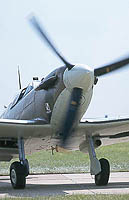 On both days a salute
was taken by some of the RAF veterans, British, Commonwealth and Polish,
who fought off threatened invasion during the summer and autumn of 1940. This year author
and award winning TV producer, Graham Hurley, brought together fascinating contemporary
footage of plotters and ground crews at work, Hurricane and Spitfire production lines,
pilots scrambling and other evocative images of Britain at war, all shown on giant
airfield screens to enhance the 'Theatre of the Air' concept. On both days a salute
was taken by some of the RAF veterans, British, Commonwealth and Polish,
who fought off threatened invasion during the summer and autumn of 1940. This year author
and award winning TV producer, Graham Hurley, brought together fascinating contemporary
footage of plotters and ground crews at work, Hurricane and Spitfire production lines,
pilots scrambling and other evocative images of Britain at war, all shown on giant
airfield screens to enhance the 'Theatre of the Air' concept.
The tribute began with a Hurricane
acrobatic display to symbolise the maiden flight of the fighter in November 1935, followed
by the Tiger Moth, Tutor and Magister aircraft used for flying training in the pre-war
era. Actors Matt Burgess and Victoria Woodward played wartime sweethearts, telling the
story of ordinary people living through the Battle of Britain. As a Spitfire makes a shaky
take-off Matt, in the 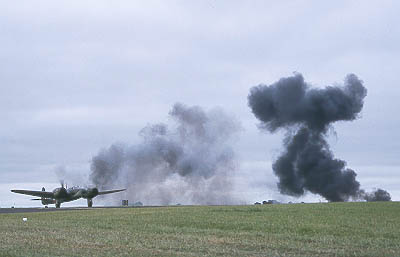 role of a young pilot, talked about his first solo flight, the
script, written by RIAT commentator Sean Maffett, being based on the memories of veterans
who joined the Royal Air Force in the late 1930s. A Spitfire
demonstration followed, showing how RAF pilots were taught to dogfight. A simulated crash
then followed as one pilot has trouble landing, perhaps the only moment of questionable
taste, as many in the crowd were duped into believing the crash was real! role of a young pilot, talked about his first solo flight, the
script, written by RIAT commentator Sean Maffett, being based on the memories of veterans
who joined the Royal Air Force in the late 1930s. A Spitfire
demonstration followed, showing how RAF pilots were taught to dogfight. A simulated crash
then followed as one pilot has trouble landing, perhaps the only moment of questionable
taste, as many in the crowd were duped into believing the crash was real!
Part two, about an hour later, opened in the
summer of 1940 as Spitfires and Hurricanes scramble to intercept
the Luftwaffe, accompanied by dramatic pyrotechnics. Missing Man formations, flown by the
RAF and Canadian Air Forces symbolised peace, as well as honouring the RAF and Luftwaffe
pilots who perished. Four German Tornados had intended to take part, but the low
cloud-base put paid to this on both days.
Other vintage aircraft assembled for the
tribute, including Messerschmitt 108s operating from nearby Duxford Aerodrome,
representing the Luftwaffe's build-up in the late thirties.
Hurricane Pilot for real
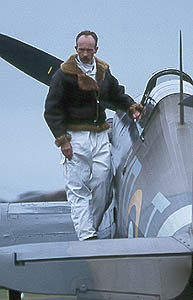  One veteran of the Battle attending was Air Commodore Peter Brothers, CBE DSO
DFC, , 82, who learned to fly at sixteen and joined the Royal Air Force
in 1936. By late 1938 he was Flight Commander of 32 Squadron at Biggin Hill. During the
Battle of Britain he flew with both 32 and 257 Squadrons, and on 13 September was awarded
the DFC. One veteran of the Battle attending was Air Commodore Peter Brothers, CBE DSO
DFC, , 82, who learned to fly at sixteen and joined the Royal Air Force
in 1936. By late 1938 he was Flight Commander of 32 Squadron at Biggin Hill. During the
Battle of Britain he flew with both 32 and 257 Squadrons, and on 13 September was awarded
the DFC.
Describing just one of scores of Battle of Britain engagements, he says "The
telephone rings, followed by a shout of "32 Squadron scramble - Maidstone angels
20". I rush to my aircraft, fasten parachute and safety harness, start up, and take
off leading my "B" Flight I climb hard heading for Maidstone, then the CO calls
'Tally Ho" and there they are - a solid mass of about 200 bombers with an Me 109
escort above. I think "We are twelve, where the blazes do we start on this lot?"
We have hardly any height advantage as the CO leads 'A' Flight swinging left into the 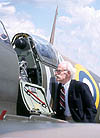 middle of the bomber formation. I follow with "B"
Flight, but a stream of tracer bullets pass close by and I have to break off and go for
the Me 109 attacking me. We whirl in a tight circle, I get a shot at him and he dives
down. I follow. I'm not sure I have hit him so I am surprised when he hit the
ground." Flight Lieutenant Peter Brothers landed safely, spent of ammunition, despite
the holes made by the Me 109. In all, he downed twelve enemy aircraft during the Battle. middle of the bomber formation. I follow with "B"
Flight, but a stream of tracer bullets pass close by and I have to break off and go for
the Me 109 attacking me. We whirl in a tight circle, I get a shot at him and he dives
down. I follow. I'm not sure I have hit him so I am surprised when he hit the
ground." Flight Lieutenant Peter Brothers landed safely, spent of ammunition, despite
the holes made by the Me 109. In all, he downed twelve enemy aircraft during the Battle.
Awarded a Bar to his DFC on 15 June 1943 and the DSO on 3 November 1943, Air Commodore
Brothers had a long and distinguished career in the Royal Air Force - taking two years out
from 1947 to 1949 to join the Colonial Service in Kenya. He retired from the RAF in 1973,
and is now Deputy Chairman of the Battle of Britain Fighter Association.
 The tribute was a
brave attempt by the organisers to do something different, and largely succeeded, if too
long; a single hour of more concise action would have been better, with more emphasis on
the flying. South African DC4 stood in as the attacking Heinkel, so
more than a little imagination was required, while the intended Me109 failed to appear,
leaving the assembled Spitfires and Hurricanes with no fighters to chase. It's at moments
like this that we think of Mark Hanna, and how he would have been there mixing it with his
Buchon... The tribute was a
brave attempt by the organisers to do something different, and largely succeeded, if too
long; a single hour of more concise action would have been better, with more emphasis on
the flying. South African DC4 stood in as the attacking Heinkel, so
more than a little imagination was required, while the intended Me109 failed to appear,
leaving the assembled Spitfires and Hurricanes with no fighters to chase. It's at moments
like this that we think of Mark Hanna, and how he would have been there mixing it with his
Buchon...
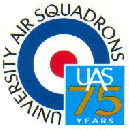 75 Years of the University Air Squadrons 75 Years of the University Air Squadrons
Millennium Falcons
The epic Millennium Falcon Flight
took off from Cottesmore on Thursday carrying young air cadets who plan to be the RAF's
next generation of fighter pilots. A three-ship of Vigilant motor gliders flew out at
lunchtime, also marking the climax to a fund raising challenge set by BAE SYSTEMS to the
Air Training Corps.
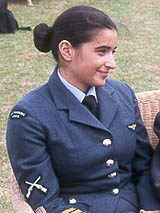 Cadet Flight
Sergeant Gil Lakpour, 18, of 1036 (Bury) Squadron Air Training Corps and two other cadets
flew out on the first leg of the historic flight around the UK. Gil hopes to join the
Royal Air Force as a fast jet pilot, and already has her gliding wings, winning a coveted
RAF Flying Scholarship - all this before getting her driving licence. Cadet Flight
Sergeant Gil Lakpour, 18, of 1036 (Bury) Squadron Air Training Corps and two other cadets
flew out on the first leg of the historic flight around the UK. Gil hopes to join the
Royal Air Force as a fast jet pilot, and already has her gliding wings, winning a coveted
RAF Flying Scholarship - all this before getting her driving licence.
On the flight, pilots and cadets collected money raised for charity as part of a challenge
set by BAE SYSTEMS. Two years ago BAE SYSTEMS challenged the ATC with raising £100,000
for charity promising to match it pound for pound. The project was given the royal seal of
approval by the Air Training Corps' Commodore in-Chief, HRH The Duke of Edinburgh, who
expressed his delight during the early stages when funds raised were well above target.
 Group Captain Mike Cross, Chief of Staff Air Cadets said:
"It will not come as a surprise to anyone with any knowledge of the ATC, and calibre
and enthusiasm of the cadets, to learn that the Air Training Corps has exceeded the target
to the tune of £350,000 for charity. The cadets have also raised £2 million towards
their own self-help funds to pay for vehicles and adventure training." To acknowledge
this achievement in the millennium year the Flight of the Millennium Falcons, piloted by
experienced instructors from the Central Gliding School, Syerston, Notts, set off on an
historic ten-day journey covering a distance in excess of 3,000 nautical miles, flying the
length and breadth of the United Kingdom. The Falcons' journey took them over the
southernmost point of mainland England, Preddannack on the Lizard, the very tip of
Cornwall to Kinloss in northern Scotland and included a crossing of the Irish Sea to
Northern Ireland. During the flight cadets accompanied the crews from all six regions of
the Air Training Corps and collected money raised for charity. The culmination of the
marathon flight took place on Saturday 29 July at the Farnborough Airshow. Elsewhere at
Cottesmore, many Vigilants, Grob Tutors and Bulldogs could be found in the static park,
maybe one reason they could get so many heavies in, which brings us nicely to... Group Captain Mike Cross, Chief of Staff Air Cadets said:
"It will not come as a surprise to anyone with any knowledge of the ATC, and calibre
and enthusiasm of the cadets, to learn that the Air Training Corps has exceeded the target
to the tune of £350,000 for charity. The cadets have also raised £2 million towards
their own self-help funds to pay for vehicles and adventure training." To acknowledge
this achievement in the millennium year the Flight of the Millennium Falcons, piloted by
experienced instructors from the Central Gliding School, Syerston, Notts, set off on an
historic ten-day journey covering a distance in excess of 3,000 nautical miles, flying the
length and breadth of the United Kingdom. The Falcons' journey took them over the
southernmost point of mainland England, Preddannack on the Lizard, the very tip of
Cornwall to Kinloss in northern Scotland and included a crossing of the Irish Sea to
Northern Ireland. During the flight cadets accompanied the crews from all six regions of
the Air Training Corps and collected money raised for charity. The culmination of the
marathon flight took place on Saturday 29 July at the Farnborough Airshow. Elsewhere at
Cottesmore, many Vigilants, Grob Tutors and Bulldogs could be found in the static park,
maybe one reason they could get so many heavies in, which brings us nicely to...
 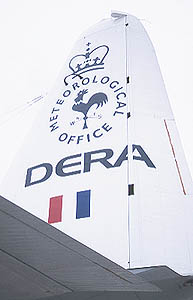 AIRLIFT 2000 AIRLIFT 2000
Some of the world's biggest aircraft dominated the skyline
at Cottesmore over the weekend. Airlift 2000 paid tribute to military transport crews and
their work in delivering life-saving humanitarian supplies or evacuating civilians in
situations such as the current Sierra Leone operation. Although the wisdom of holding such
a get-together at a smaller base than Fairford was questioned, on the weekend it all
slotted in to place admirably, with almost as many C130s, KC135s and other multi-engined
transport types as is normally to be found at any IAT.
Giants of the show were a US Air Force C5B
Galaxy, capable of transporting six Apache helicopters in its massive hold, a Royal
Netherlands Air Force KDC10, and a C17A
Globemaster III, flown by RAF Exchange Officer Squadron Leader Darrell Jacobs. A South
African Air Force C130 made the 12,000-mile round-trip to attend RIAT 2000.
 Visitors could visit the national heritage
exhibition set up in the Royal Jordanian Air Force C130 Hercules, which also housed a
temporary mosque for the crew during their stay, and saw how the Royal Danish Air Force
equips its C130s for aero-medical evacuations. XV208, 'Snoopy',
an RAF Hercules equipped with technology for global meteorological analysis, was also on
static display. Europe's oldest 'Fat Albert', celebrating its 35th birthday, was displayed
by Swedish Air Force pilot Captain Goran Wasthed. In a long career of humanitarian
missions, this C130 was operated for the Swedish Red Cross during the 1968 Biafran crisis.
Victim of the weather was a proposed flypast by a South African Airways Boeing 747-444,
which would have brought us right up to date from the DC4. Visitors could visit the national heritage
exhibition set up in the Royal Jordanian Air Force C130 Hercules, which also housed a
temporary mosque for the crew during their stay, and saw how the Royal Danish Air Force
equips its C130s for aero-medical evacuations. XV208, 'Snoopy',
an RAF Hercules equipped with technology for global meteorological analysis, was also on
static display. Europe's oldest 'Fat Albert', celebrating its 35th birthday, was displayed
by Swedish Air Force pilot Captain Goran Wasthed. In a long career of humanitarian
missions, this C130 was operated for the Swedish Red Cross during the 1968 Biafran crisis.
Victim of the weather was a proposed flypast by a South African Airways Boeing 747-444,
which would have brought us right up to date from the DC4.
The US Air National Guard, based at Scotia,
New York, had one of its ski-equipped C130s on static display. On 17 October 1999 a
similar aircraft operated by this unit airlifted Dr Jerri Neilsen, suffering from
suspected breast cancer, from a remote polar scientific base in temperatures of minus 53C.
The C130 landed on a runway cut out of the ice, several weeks before the summer flying
season to the South Pole was due to open. The pilot, Major George McAllister, who was at
Cottesmore, said at the time "It was at the limits of the operational abilities of
the plane. Mother Nature didn't seem like she was going to co-operate, but then she
did".
Part four: Colours on show
|
 75 Years of the University Air Squadrons
75 Years of the University Air Squadrons